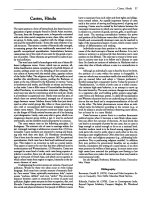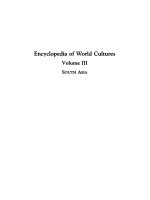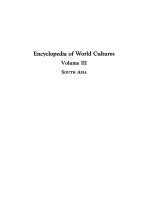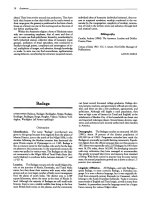Encyclopedia of World Cultures Volume III - South Asia - T ppt

Encyclopedia of World Cultures Volume III - South Asia - T ppt
... of spe- cific deities is a transcendent divinity, bhagavan or devudu, re- sponsible for cosmic order. People conceive of this deity in personified forms such as Vishnu and his associated circle of gods-including his ten incarnations, among whom are Rama and Krishna, and their various female consorts, such as Lakshmi, Sita, and Rukmini. Shiva and gods associated with him include his sons...
Ngày tải lên: 02/07/2014, 20:20

Encyclopedia of World Cultures Volume III - South Asia - C ppt
... to the government. The Chakma raja traditionally received a small portion of tax on swidden land. Kinship Kin Groups and Descent. The paribar (family) is the basic kinship unit in Chakma society. Beyond the paribar and bari (homestead), multihousehold compounds are the next widest unit, the members of which may form work groups and help each other in other activities. Next are the hamlets...
Ngày tải lên: 02/07/2014, 20:20

Encyclopedia of World Cultures Volume III - South Asia - I ppt
... the central and state governments. Conflict. The Irula, beset by circumstances forcing change upon them from the outside world, are liable to come into conflict with their neighbors. Our best retrospective example of this is offered by the hamlet of Koppayur, on an eastern slope of the Nilgiris. The British managers on the nearby Kil- kotagiri tea estate enabled the Irula to continue...
Ngày tải lên: 02/07/2014, 20:20

Encyclopedia of World Cultures Volume III - South Asia - L pptx
... and Chins). The relationship between the British and the Lakhers was characterized by intermittent conflict, extending from the middle of the nineteenth century to 1924, at which time all the Lakher tribes were brought under British control. British rule brought both political and economic stability to the region. Villages enjoyed a period of internal and external security, slav- ery was...
Ngày tải lên: 02/07/2014, 20:20

Encyclopedia of World Cultures Volume III - South Asia - Appendix ppt
... northern and central India, numbering several millions. Their traditional occupation was tapping palms for the sap, but they also used to be thieves. Now some are hunters and fowlers; most are farmers. (Risley 1891, 2:16 6-1 68; Crooke 1896, 4:13 8-1 52; Thurston and Rangachari 1909, 6:15 8-1 59; Rose 1911, 2:204; Russell and Hira Lal 1916, 4:38 0-3 85) Patari (Pathari) A caste of p...
Ngày tải lên: 02/07/2014, 20:20

Encyclopedia of World Cultures Volume III - South Asia - Overview pot
... people from cultures different from our own. "We" is used here in the broadest sense, to include not just scholars who study the cul- tures of the world and businesspeople and government offi- cials who work in the world community but also the average citizen who reads or hears about multicultural events in the news every day and young people who are growing up in this compl...
Ngày tải lên: 02/07/2014, 20:20

Encyclopedia of World Cultures Volume III - South Asia - A doc
... or five families stay in one camp. As the wet season ends, each family moves to its clan's traditional hut, which is circular and houses from fifteen to twenty sleeping platforms. A clan's hut is stationary and is maintained throughout the year by the men of the clan. With the exception of a clan's hut, all housing is temporary. A clan's hut, usually 5 to 7 me- ters in...
Ngày tải lên: 02/07/2014, 20:20

Encyclopedia of World Cultures Volume III - South Asia - B potx
... the cultural heritage. Yet the vibrant change (tambourine) dance of the villagers in front of the commu- nity hall is very common after the day's toil and particularly on festive occasions. Medicine. People, crops, and cattle are believed to be pro- tected from diseases by the village tutelary deity. The propiti- ation of other deities also is thought to help protect people from di...
Ngày tải lên: 02/07/2014, 20:20

Encyclopedia of World Cultures Volume III - South Asia - D,E,F doc
... old culture is comprised of three main layers: the Tamil-Malayalam substratum with its many subtle roots; old Sinhala culture and language, which is the dominant element; and the phase of Arabic in- fluence. But the Maldives were touched by every cultural wind that passed over the Indian Ocean. Since independence there has again been influence from Sri Lanka, through its teachers brought...
Ngày tải lên: 02/07/2014, 20:20

Encyclopedia of World Cultures Volume III - South Asia - G pot
... the Gujarati population are tribals who predominantly live in the eastern hilly belt. Sixty-nine percent of the population live in rural areas and 31 percent live in urban areas. Ahmadabad, Surat, Vadodara, and Rajkot are large cities. linguistic Affiliation. Gujarati is considered by linguists to be a member of the outer circle of Indo-Aryan languages: it is partly Prakritic and partly...
Ngày tải lên: 02/07/2014, 20:20